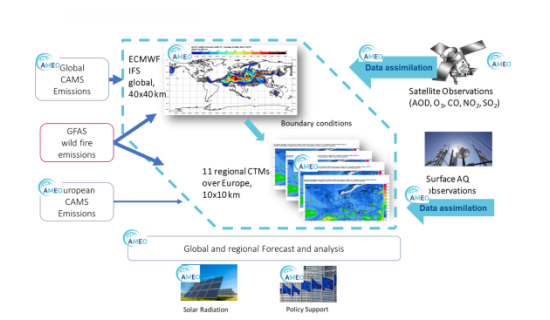Project CAMEO
CAMS EvOlution
The CAMS Service Evolution (CAMEO) project will enhance the quality and efficiency of the CAMS service and help CAMS to better respond to policy needs such as air pollutant and greenhouse gases monitoring, the fulfilment of sustainable development goals, and sustainable and clean energy.
CAMEO will help prepare CAMS for the uptake of forthcoming satellite data, including Sentinel-4, -5 and 3MI, and advance the aerosol and trace gas data assimilation methods and inversion capacity of the global and regional CAMS production systems. CAMEO will develop methods to provide uncertainty information for users of CAMS emissions, policy, solar radiation and deposition products in response to prominent requests from current CAMS users. CAMEO will contribute to the medium to long-term evolution of the CAMS production systems and products. The transfer of developments from CAMEO into subsequent improvements of CAMS operational service elements is a main driver for the project and is the main pathway to impact for CAMEO. The CAMEO consortium, led by ECMWF, the entity entrusted to operate CAMS, includes several CAMS partners thus allowing CAMEO developments to be carried out directly within the CAMS production systems and facilitating the transition of CAMEO results to future upgrades of the CAMS service. This will maximise the impact and outcomes of CAMEO as it can make full use of the existing CAMS infrastructure for data sharing, data delivery and communication, thus supporting policymakers, business and citizens with enhanced atmospheric environmental information.
Activities carried out by ENEA:
The activities foreseen by the CAMEO project represent the natural continuation of the CAMS50 project (leader Meteo France), carried out with 9 other European institutes and of the CAMS2_40 project which foresees the implementation of the MINNI model like the other partners.
The proposed activity allows Italy and the ENEA model (widespread among others in many Regional Environmental Agencies) to develop new functionalities useful for the CAMS services and maintain a level of development equal to the other modeling systems of the CAMS2_40 project. ENEA will have to develop within the MINNI modeling system the ability to be able to assimilate the products of the Tropomi satellite sensor mounted on one of the Sentinel constellation satellites within the Copernicus programme.
In particular, the activity includes:
• to innovate already existing assimilation algorithms
• to produce numerical assimilation experiments for the pollutants CO, O3, SO2 and NO2
• to produce periodic reports on the activities carried out.

